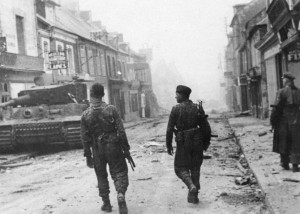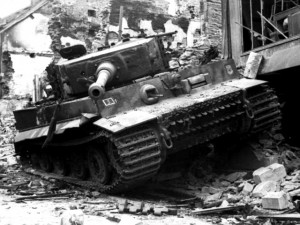After the close encounter with Stan Lockwood’s Firefly, Wittmann knew that his run of success had come to an end. He had risked entering the town alone, but taking on more potent enemy armour in such an enclosed space was too much of a challenge, even for a vehicle as powerful as the Tiger. It was now time to head out of Villers and back towards Point 213.
Making his way back to German lines would have capped off the highly successful action in the best way possible, but it was not to be.
Having turned away from the threat posed by the advancing tanks of “B” Squadron to the west of the settlement, Wittmann headed back down Rue Georges Clémenceau, where his Tiger was struck on the tracks – its weakest point – by what Wittmann believed to be a shell from a British 6-pdr anti-tank gun located in a small side alleyway between Boulevard Joffre and Rue Jeanne Bacon. Given the earlier exchanges with far heavier Allied weaponry, that the mighty Tiger was disabled by the comparatively lightweight 6-pdr was more than ironic.
Huet-Godefroy: Exit and escape
With one of the Tiger’s drive sprockets damaged by the shell, it quickly ground to a halt in front of the Huet-Godefroy clothes store. Knowing that further action was impossible, Wittmann and his crew secured their position before exiting their vehicle in the hope that it might be later retrieved.
It was a moment of regret for Wittmann, who felt that there were plenty more targets on offer; however, with just their sidearms the Tiger commander and his crew were left with little choice but to leave their stricken vehicle and make good their escape. With British forces still present in the town, going back the way they came was too much of a risk; their only option was to exit to the north and towards the position held by the Army’s elite Panzer-Lehr Division.
Meanwhile back at Hill 213 the remainder of “A” Squadron had found themselves first up against the two other Tigers of Hantusch and Brandt, who were joined by Sowa’s half-fit Tiger 234 and then by the support vehicles of 4. Kompanie. By 10:35 the stretch of the N 175 between Hill 213 and Villers had been secured, and this first stage of the battle was effectively over as the Germans set about flushing the remaining “A” Company personnel from their hiding places.
On foot to Panzer-Lehr
Having successfully made their way out of the Villers-Bocage, Wittmann and his crew succeeded in safely making their way some seven kilometers on foot back to the HQ of the Panzer-Lehr Division at Chateau d’Orbois. Here, all of the “out of vehicle” training was put to good use. After delivering his report, Wittmann immediately looked to return to his unit.
Wittmann was initially accompanied by fifteen Panzer VIs of the 2nd Battalion, 130th Regiment of Panzer-Lehr, commanded by Hauptmann Helmut Ritgen. Heading back south towards Villers, the group had advanced close to the village of Maizerais just south of Gournay en Bray, before coming under heavy enemy fire. With the Panzers needing to consolidate their position, Wittmann continued eastwards in an amphibious Schwimmwagen.
By the middle of the afternoon Wittmann had reached his destination, arriving at more or less the same point from where he had departed for Villers in his Tiger earlier that morning. As German forces rounded up the few remaining British stragglers, Wittmann reported back to headquarters.
The afternoon attack
In the early to mid afternoon, the second wave of Tigers from the 101st’s 1. Kompanie led by SS-Hauptsturmführer Rolf Möbius made their way down the N 175 into Villers-Bocage in an attempt to take and secure the town centre. This time however there was no element of surprise, and the British were waiting.
Under the command of Lieutenant Bill Cotton, the Fireflies of 4CLY’s “B” Squadron would hold their own against the Tigers: in stark contrast to Wittmann’s efforts earlier in the day that had left the British in disarray, five of Möbius’s Tigers were left abandoned in the centre of town.
Along with Wittmann’s tank that had been left outside Huet-Godefroy, this meant that six of the precious Tigers had been either disabled or lost along with two Panzer IVs from Panzer-Lehr. In order to prevent their being repaired at a later point, Cotton’s men had inflicted additional damage on the stationary German vehicles by “cooking” them with blankets and petrol.(1)
The German interpretation
With the war going against Germany on all fronts, positive stories were hard to come by. During the early stages of the war, the weekly Deutsche Wochenschau newsreel was nothing but a catalogue of success for the German forces and Nazi leadership; by the summer of 1944, it was all about keeping up the fight against ever-increasing odds and maintaining morale.
Naturally, the story of Michael Wittmann’s exploits at Villers-Bocage was a gift. In the wake of the Normandy invasion, the sight of broken and burning Allied vehicles captured on film provided the perfect propaganda boost. It showed the German people that no matter how hard things may have been at home, soldiers like Wittmann were still doing all they could to turn things around and secure the final victory.
[youtube=http://www.youtube.com/watch?v=JBLrtDpRUDc&w=640&h=360]
Wittmann was now a hero in Germany. His action at Villers-Bocage only held up the Allied advance for a short time, but for those back in Germany it was one of the few bright moments in a desperate conflict.
Two heroes
The events of 13th June would actually produce two heroes. While Michael Wittmann was awarded the swords to his Knight’s Cross following the morning assault, the defence of Villers-Bocage in the afternoon would earn Bill Cotton the Military Cross.


